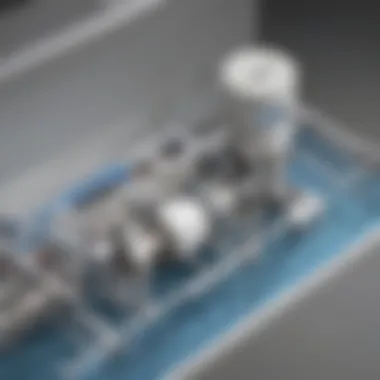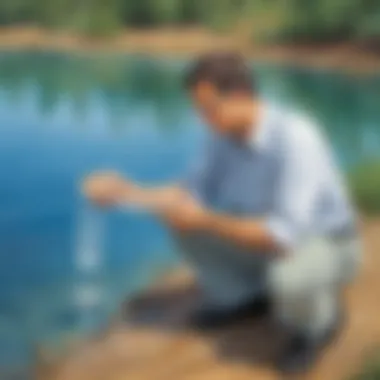Step-by-Step Guide to Creating a Water Filtration System at Home


Science Fun Facts
Water filtration systems have been utilized for centuries to ensure access to clean drinking water. Did you know that ancient civilizations like the Greeks and Romans used various methods like boiling and filtering to purify their water sources? It's fascinating how our ancestors valued the importance of clean water even without the advanced technology we have today.
Discover the Wonders of Science
Water filtration is a fascinating scientific process that involves the removal of impurities and contaminants from water to make it safe for consumption. Understanding the science behind filtration methods such as reverse osmosis and activated carbon can offer insights into how we can improve the quality of our drinking water.
Science Experiment Showcase
Engaging in water filtration experiments can be a fun way to learn more about the importance of clean water. By demonstrating simple filtration techniques using materials like gravel, sand, and activated charcoal, children can gain a hands-on understanding of how impurities are removed from water to make it safe to drink.
Science Quiz Time
Test your knowledge on water filtration with interactive quizzes that challenge your understanding of the filtration process. With questions ranging from the differences between sediment and carbon filters to the importance of backwashing in maintaining filter efficiency, these quizzes can be both educational and entertaining for young learners.
Introduction
In today's society, where clean water accessibility remains a significant concern, the creation of water filtration systems emerges as a paramount solution. The Introduction section of this comprehensive guide aims to shed light on the critical aspects of water filtration, emphasizing the pivotal role it plays in providing safe drinking water. Clean water is not only essential for hydration but also for various daily activities, such as cooking and personal hygiene. Understanding the intricacies of water filtration equips individuals with the knowledge required to ensure their water sources are free from contaminants and impurities.
Importance of Clean Water
Clean water stands as a fundamental necessity for sustaining life on our planet. Countless health benefits are associated with consuming clean water, including improved digestion, enhanced immune function, and overall well-being. In addition to its direct impact on human health, clean water also safeguards the environment by preserving aquatic ecosystems and promoting biodiversity. Recognizing the importance of clean water sets the foundation for appreciating the role of water filtration in securing access to uncontaminated water sources.
Overview of Water Filtration


Water filtration encompasses a diverse range of techniques designed to purify water by removing pollutants and particles. By familiarizing oneself with the different filtration methods available, individuals can make informed decisions regarding the most suitable approach for their specific needs. From physical filtration methods like Screen Filters and Microfiltration to Chemical Filtration Techniques such as Activated Carbon and Reverse Osmosis, each method offers unique benefits in ensuring water safety. A comprehensive overview of water filtration provides a holistic understanding of how these techniques work together to deliver clean and potable water for consumption.
Understanding Filtration Techniques
Understanding Filtration Techniques is a critical aspect of creating a water filtration system. By delving into the different methods of filtration, one can grasp the intricacies involved in purifying water. Whether it is physical, chemical, or biological filtration, understanding the techniques helps in selecting the most effective method for specific water quality issues. This section aims to shed light on the significance of filtration techniques in ensuring clean and safe drinking water.
Physical Filtration Methods
Screen Filters
Screen Filters play a pivotal role in trapping large particles from water, such as debris and sediments. Their fine mesh design allows water to pass through while capturing contaminants effectively. The key characteristic of Screen Filters lies in their ability to remove visible impurities efficiently, making them a popular choice for pre-filtration in water treatment processes. The unique feature of Screen Filters is their versatility in capturing various particle sizes, although they may require frequent cleaning to maintain optimal performance.
Depth Filters
Depth Filters are known for their depth media, which can retain a broad range of particle sizes. Their functionality in removing suspended solids and colloids from water makes them a reliable choice for water purification. The key characteristic of Depth Filters is their high dirt-holding capacity, enabling prolonged use before replacement. Although Depth Filters offer excellent filtration, their pressure drop might impact flow rates and require attention during system design.
Microfiltration
Microfiltration involves using microscopic pores to filter out contaminants, including bacteria and some viruses. The key characteristic of Microfiltration is its ability to achieve high removal efficiencies for pathogens, making it ideal for producing microbiologically safe water. The unique feature of Microfiltration lies in its precise size exclusion, ensuring only particles larger than the membrane's pore size are retained. However, frequent membrane fouling is a drawback that necessitates regular maintenance in Microfiltration systems.
Chemical Filtration Methods
Activated Carbon
Activated Carbon is renowned for its exceptional adsorption properties, effectively removing organic compounds, chlorine, and odors from water. The key characteristic of Activated Carbon is its large surface area that enhances adsorption capacity, making it a versatile choice for improving water taste and quality. The unique feature of Activated Carbon is its regeneration capability through backwashing, prolonging its operational lifespan. Despite its advantages, Activated Carbon may require periodic replacement to maintain optimal filtration efficiency.
Ion Exchange


Ion Exchange is a method that involves exchanging ions in water with ions on a resin surface to remove dissolved ions such as calcium and magnesium. The key characteristic of Ion Exchange is its selective removal of specific ions, providing tailored water treatment solutions. The unique feature of Ion Exchange is its ion regeneration capability, offering extended use without immediate resin replacement. However, Ion Exchange systems require monitoring to prevent resin exhaustion and maintain efficiency.
Reverse Osmosis
Reverse Osmosis utilizes a semipermeable membrane to remove a wide range of impurities from water, including dissolved solids and heavy metals. The key characteristic of Reverse Osmosis is its high rejection rate of contaminants, producing purified water suitable for various applications. The unique feature of Reverse Osmosis is its low energy consumption compared to distillation, making it a cost-effective solution for clean water production. Despite its benefits, Reverse Osmosis systems may produce wastewater and require regular membrane cleaning for sustained performance.
Biological Filtration Methods
Slow Sand Filters
Slow Sand Filters rely on biological processes to remove pathogens and suspended solids from water. The key characteristic of Slow Sand Filters is their natural purification mechanism, creating a sustainable and eco-friendly filtration solution. The unique feature of Slow Sand Filters is their self-renewing biological layer, enhancing filtration efficiency over time. However, Slow Sand Filters may have slower filtration rates compared to other methods, requiring larger surface areas for treatment.
Biological Activated Carbon Filtration
Biological Activated Carbon Filtration integrates activated carbon with microbial processes to eliminate contaminants from water. The key characteristic of Biological Activated Carbon Filtration is its dual-action mechanism, combining adsorption with biological degradation for comprehensive water treatment. The unique feature of Biological Activated Carbon Filtration is its capability to remove a wide range of pollutants effectively. Despite its effectiveness, Biological Activated Carbon Filtration requires proper monitoring of microbial activity to prevent biomass accumulation and maintain consistent performance.
Membrane Bioreactors
Membrane Bioreactors employ membrane filtration alongside biological treatment to produce high-quality effluent. The key characteristic of Membrane Bioreactors is their compact design and excellent solids removal efficiency, making them suitable for space-restricted environments. The unique feature of Membrane Bioreactors is their advanced filtration technology, ensuring superior water quality standards. However, membrane fouling remains a challenge in Membrane Bioreactor systems, necessitating regular cleaning and maintenance to sustain filtration efficiency.
DIY Water Filtration System
In the realm of water purification, the DIY Water Filtration System stands out as a beacon of self-sufficiency and environmental consciousness. This segment within the broader theme of creating a water filtration system delves into the hands-on approach individuals can take to safeguard their water quality. By embracing the DIY ethos, individuals not only gain a deeper appreciation for the intricacies of water filtration but also contribute to sustainability efforts in their communities. The beauty of DIY water filtration lies in its customizable nature, allowing individuals to tailor their systems to their specific needs and resources.
Materials and Tools Required
When embarking on the journey of constructing a DIY water filtration system, essential materials and tools become pillars of the project's success. Basic components like filter media, containers, piping, and filtration mechanisms form the backbone of the system. Tools such as drills, saws, measuring tapes, and wrenches are indispensable for assembling the filtration unit. Selecting high-quality materials ensures the longevity and efficiency of the system, emphasizing the importance of research and care in the procurement process.


Construction Process
Step 1: Gathering Materials
Step 1 marks the inception of the DIY water filtration project, where meticulous selection of materials sets the stage for success. From choosing the right filter media to selecting durable containers, each decision impacts the system's overall performance. The careful consideration of each component's characteristics, such as porosity and reusability, influences the filtration system's efficacy. By prioritizing materials with high filtration rates and minimal maintenance requirements, builders lay a solid foundation for operational efficiency.
Step 2: Building the Filtration Unit
In Step 2, the focus shifts from material selection to the actual construction of the filtration unit. Assembling the components with precision and attention to detail ensures a seamless integration of each part. The strategic placement of filters, connectors, and support structures optimizes water flow and filtration effectiveness. Incorporating features like removable parts and transparent sections enhances user experience and facilitates maintenance, underlining the importance of user-friendly design in filtration system construction.
Step 3: Testing the System
The culmination of the DIY water filtration process lies in Step 3, where system testing validates its functionality and efficiency. Conducting flow rate tests, water quality assessments, and filtration performance evaluations verifies the system's capability to deliver clean, safe water. Regular monitoring and adjustment post-testing guarantee continuous optimal performance. By implementing rigorous testing procedures, builders instill confidence in the system's reliability and promote a culture of quality assurance in water filtration endeavors.
Regular Maintenance Tips
Amidst the intricate process of creating and sustaining a water filtration system, the adherence to regular maintenance practices emerges as a non-negotiable component for optimal functionality and longevity. Imbued with a sense of responsibility towards maintaining the integrity of the filtration system, individuals can leverage a range of fundamental maintenance tips to uphold the efficiency and effectiveness of the system.
Commencing with a structured approach to maintenance, prioritizing tasks such as periodic filter replacement, thorough system cleaning, and inspection of components for wear and tear is imperative. By incorporating these routine tasks into a maintenance schedule, individuals can proactively address potential issues, mitigate risks of system malfunction, and uphold water quality standards.
Furthermore, establishing a robust maintenance routine that aligns with manufacturer recommendations and industry best practices is indispensable. Embracing a preventive maintenance mindset not only fortifies the durability of the filtration system but also minimizes the likelihood of costly repairs or replacements due to negligence. By fostering a culture of attentiveness towards system upkeep, individuals can ensure a consistent supply of clean water for domestic and personal consumption.
Conclusion
In this article, we have embarked on a journey through the intricate world of water filtration systems. The concluding segment is vital as it encapsulates the essence of our discussion. As we navigate the realm of water filtration, understanding the importance of clean water emerges as a pivotal aspect. Clean water is not merely a convenience but a fundamental right and necessity for all living beings. It is the cornerstone of health, ensuring the well-being and vitality of communities. By delving into the nuances of creating a homemade water filtration system, we equip ourselves with the power to safeguard our health and the environment. This section brings to light the practical benefits of implementing a filtration system at home, emphasizing the safety and purity it brings to our daily lives. Considerations about maintenance and periodic system checks underscore the commitment required to uphold water quality, making the conclusion a potent reminder of our responsibility towards ensuring access to safe drinking water.
Ensuring Safe and Clean Water
The concept of ensuring safe and clean water is not just a matter of convenience; it is a fundamental right and a critical component of public health. Access to clean water is essential for sustaining life and preventing waterborne illnesses. This section delves into the paramount importance of regular testing and maintenance to guarantee the quality of water from your filtration system. By incorporating best practices in monitoring water quality and adhering to maintenance routines, one can uphold the integrity of the filtration system and preserve the purity of water. Emphasizing the role of safe water in promoting overall health and well-being, this part underscores the significance of proactive measures in securing access to clean drinking water. From conducting routine tests for contaminants to implementing necessary adjustments, ensuring safe and clean water is a duty we owe to ourselves and future generations.
Final Thoughts
As we draw the curtains on our comprehensive guide to creating a water filtration system, final reflections offer a moment of introspection. The journey from understanding the importance of clean water to constructing a filtration system culminates in a profound realization of the power we hold to safeguard our health and environment. The final thoughts encapsulate a sense of empowerment and responsibility, underscoring the transformative impact of a simple yet crucial act. By reflecting on the significance of clean water and the steps taken towards securing it, we embark on a path of consciousness and action. As we part ways, let us carry forth this newfound knowledge and commitment, knowing that the journey to ensuring safe and clean water is ongoing and essential. Let our final thoughts be a catalyst for change, driving us towards a future where clean water is not just a necessity but a universal right and a shared responsibility.







